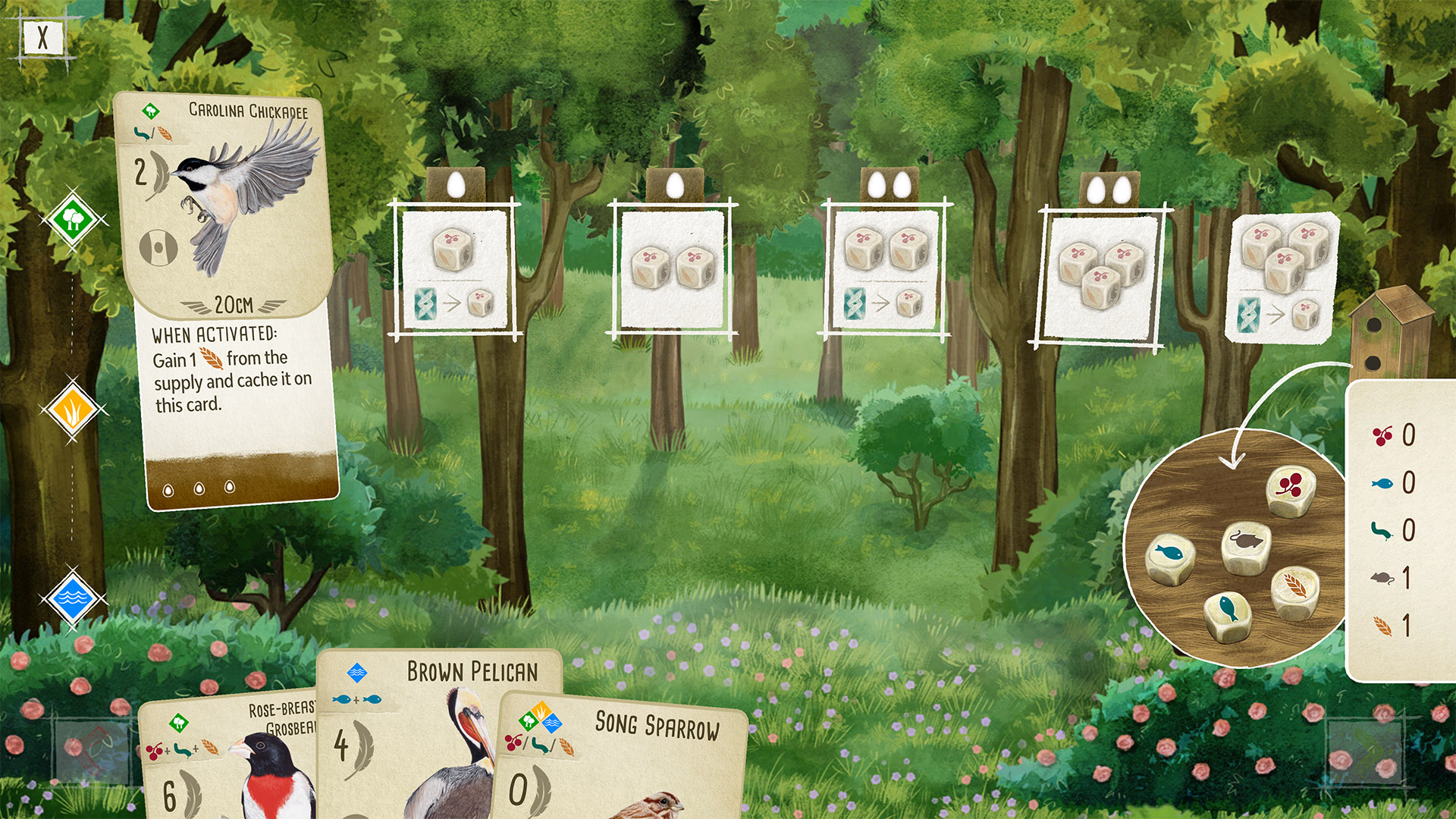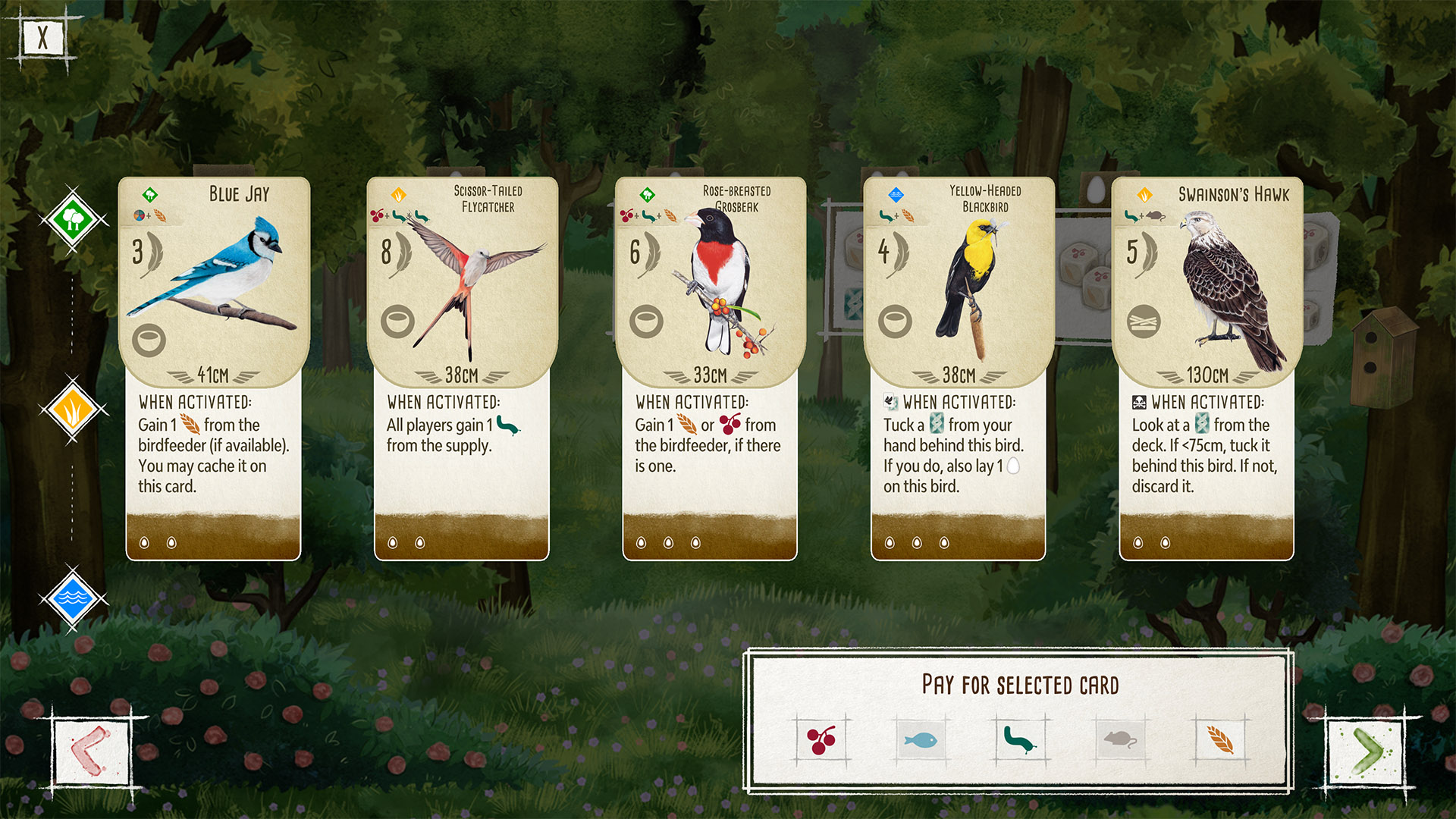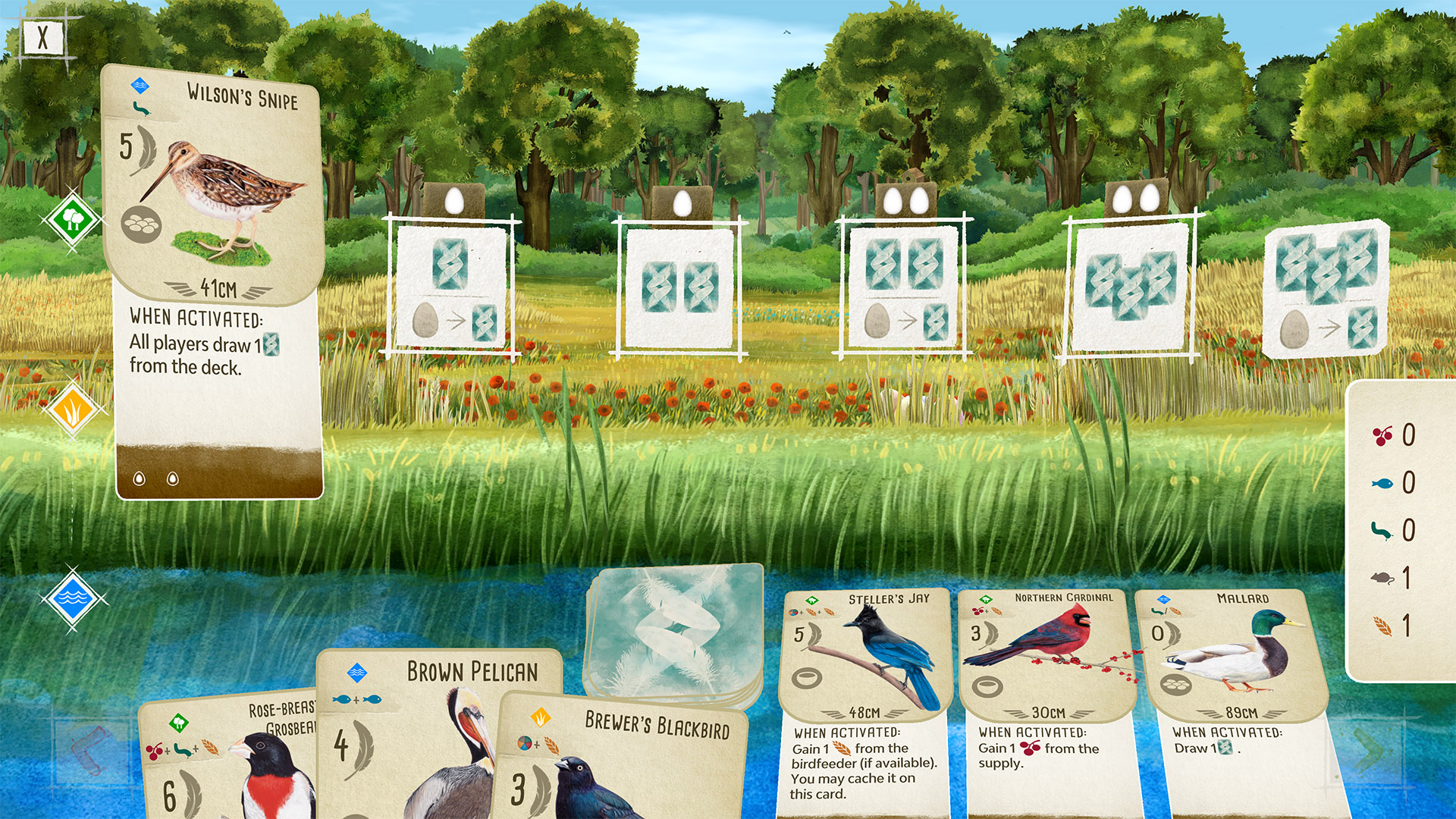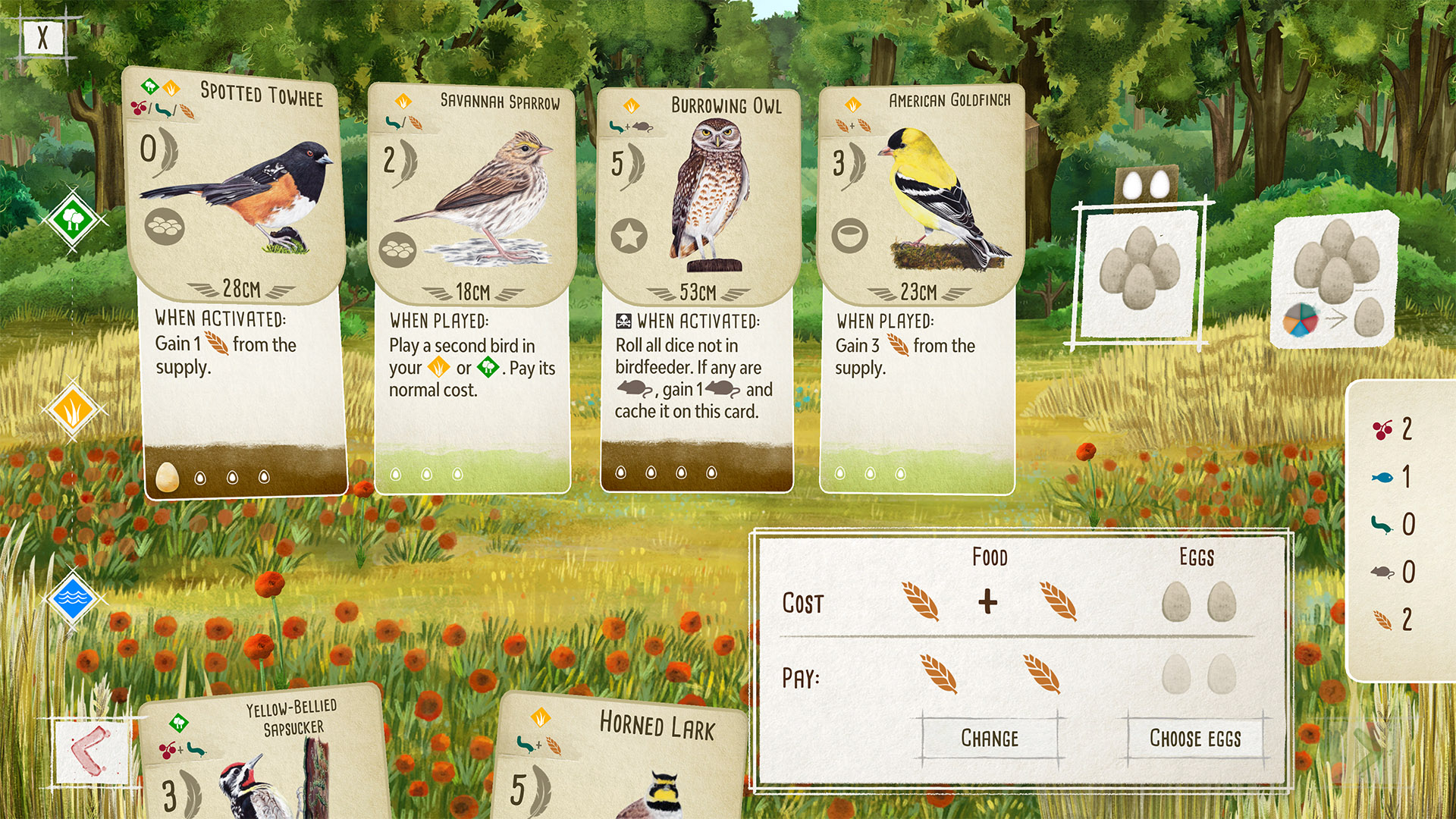
What is it? A complex strategy card game with a birding theme.
Expect to pay $16/£13.59
Release date Out now
Developer Monster Couch
Publisher Monster Couch
Reviewed on AMD FX-8350, Nvidia GeForce GTX 1070 Ti, 32GB RAM
Multiplayer? Local and online competitive.
Link Official site
If you’re anywhere near board game culture then you’ve probably heard about Wingspan. This gently thematic strategy card game about running a wildlife preserve for birds has drawn near-universal acclaim from critics and a hype train that can’t help but draw attention. Don’t let the theme deceive you, Wingspan is a game of economic strategy that can get quite complex. None of that matters when a game makes the move to digital, however. Any game can go poorly if it’s not well ported—but Wingspan is flying high as it arrives on the PC. It’s visually stunning, with beautiful audio design, charming animations, stunning attention to detail, and a layout that serves the experience of playing on a PC over mimicking the tabletop game.
Simply put, Wingspan is the new gold standard for a board game adaptation.

A flock of possibilities
Wingspan is a strategy card game where you build a strategy around the resources and cards available to you. Each turn you take a single action: Play a bird, get some food in the forest, lay eggs on birds in the field, or draw new (bird) cards at the water’s edge. As you add birds to your preserve, they empower these base actions, building an engine of bird actions and card synergies. You might play a Great Crested Flycatcher into the forest, paying a berry and a bug. From then on whenever you take the forest’s action—gaining food—you get to take an extra bug from the birdfeeder.
Each round of the game you take multiple actions, but you take fewer actions in the later rounds. That means identifying a strategy is vital: You have to empower your actions early on to make sure you’re still competitive by the end of the game. One of my favorite strategies involves cards like the Ruddy Duck and Common Yellowthroat, water birds which let you draw two extra cards, then discard one. Drawing as many cards as possible means I have to take the “Water” action to draw cards less often, saving those actions for more valuable bird playing and egg laying.
Wingspan is a competitive game—there are lots of ways to score, but the player with the most points wins—but with little in the way of aggressive, direct competition. Players compete over resources and cards, and over who can meet point-giving objectives best, but don’t play cards that directly affect others’ boards in negative ways. In fact, the tradeoff for some high-value, low-cost cards is that you actually give resources to other players.

Wingspan’s play, for all its strategy, hinges on a few very random elements. That’s the bit of the game design often cited by those who dislike it. Available food comes from a dice roll, and the birds from a huge deck. Neither choice of resources refreshes regularly without player interaction: You simply must build your strategy from what’s available, not what’s conceivable.
The carefully detailed scientific illustrations of the tabletop game are reproduced here in larger, more brilliantly colored form, and then enhanced with charming animations.
If a bird that would fulfill one of your bonus cards never shows up you’re out of luck, likewise if you need lots of, say, fish to play your birds but the dice just won’t show little blue fishies. It’s not as random and frustrating a system as something like to-hit dice in a wargame, but the tight balance of the point scoring in Wingspan can make you feel like you were prevented from victory by a bad roll of the dice.
That said, I find that Wingspan’s balance of random draws and random food against deliberate, potent, and reliable card powers is a mix of seeds in the feeder that draws me back for more over and over. There’s just so much interesting potential strategy to pull off that I want to see what combos I can come up with on the next play.

Colorful plumage
A bad digital adaptation of a board game simply reproduces the graphical and visual aspects of the base game. A good digital adaptation knows which visual and game elements to change, cut or rearrange so that the play experience flows smoothly. Wingspan is neither of these. Wingspan is a great digital adaptation, one that fundamentally adds to the experience of playing this card game. I meant it when I said in the opening of this review that all adaptations of board games in the future will have to be measured up against this one—both where it excels and where it’s lacking.
Wingspan is a beautiful game to play. The carefully detailed scientific illustrations of the tabletop game are reproduced here in larger, more brilliantly colored form, and then enhanced with charming animations. There are a variety of varied playing backgrounds to pick from too, all themselves animated.
You can even click your birds to hear their specific calls, and a narrator will read you trivia about the birds when you play them. All of it is wrapped in a lovely ambient soundscape of birdsong, nature sounds, and classical guitar. It’s a soundtrack that’s going directly into my permanent collection.

The user experience has clearly been given careful thought as well. Bird and bonus goal cards are redesigned from their tabletop form to be more readable on a screen. So has the player view: Rather than a single broad playmat you have several different screens, one for each action. A whole-player overview is available as a separate, optional choice.
Wingspan excels as a couch multiplayer or Remote Play Together game.
That’s not to say the UI is perfect. It can get crowded with a big hand of cards. It’s also not always clear what element is active, or what precisely the game wants you to click on to proceed. It’s also not as easy to track game length as on the tabletop, and the concept of “action cubes” to time your turn doesn’t translate very well to digital. The tutorial does a thorough job of teaching you the game, though, and there are plenty of videos online that will teach you the rules since those are unchanged from the tabletop version. All of that said, Wingspan is a game that actually feels like it has gained playability from the move to digital.

It’s also gained other experience benefits, like a reduced play time, and the ability to play against proper AI. The game even includes the solitaire “Automa” variant from the tabletop, which feels great, and weekly Champ of the Birds challenges to optimize your score in a set scenario against a global leaderboard.
With all these options, Wingspan excels as a couch multiplayer or Remote Play Together game. Online Multiplayer works well too, with up to five players in premade custom games. (Server issues from launch have mostly disappeared in the following weeks.) Matchmaking is available for both real-time games with a five-minute turn limit and asynchronous games with a 24-hour turn timer. The matchmaking is limited to three-player games, which might seem strange, but it’s a widespread consensus in the tabletop community that three is the optimal player count—it didn’t bother me at all.
Read our review policy
The flock of dizzying strategic possibilities and the brilliant plumage it’s dressed in make this digital board game a must-play.







More Stories
Doom Eternal review
Review: The Last of Us Part II complicates the idea of right and wrong
Dirt 5 review